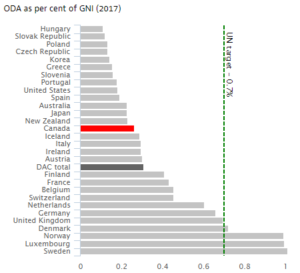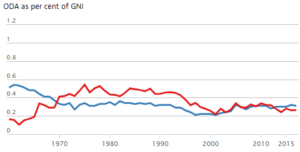
McLeod Group blog by Stephen Brown, April 16, 2018
The preliminary aid statistics for 2017 are now out. What do they tell us about global trends and Canadian foreign aid?
Globally, official development assistance (ODA) from traditional donors has held steady. The total amount, US$147 billion, is down slightly compared to 2016, but only because the amount spent on resettling refugees in donor countries has dropped. (Accounting rules allow donor countries to count certain forms of assistance to refugees in the donor country for the first twelve months after their arrival as ODA. Some countries, such as Australia, choose not to.) The proportion of aid going to African and least developed countries rose a little, suggesting that donors are collectively focusing a bit more on poor countries and a bit less on middle-income ones. Humanitarian aid went up by 6%.
Collectively, traditional donors spent 0.31% of the gross national income (GNI) on ODA in 2017, down 0.01% from the previous year and still less than half the target of 0.7% set decades ago at the UN. Five countries once again met or exceeded that commitment, namely Denmark, Luxembourg, Norway, Sweden and the United Kingdom.
How does Canada compare? Though Canada increased its ODA by 4% from 2016 to 2017, the ODA/GNI remained constant at 0.26%, cancelled out by inflation and economic growth. And if one deducts the 11% of ODA that was actually spent on refugees in Canada in 2017 (most of which is provided by provincial governments), the ratio falls to 0.23%.
Canada currently occupies the undistinguished spot of the 16th most generous traditional donor, a far cry from the target and not even close to the average (see chart below). Even Iceland and Italy have become more generous than Canada.
It has not always been so. From 1970 to 1994, Canada always provided ODA worth more than 0.4% of GNI, well above the donor average (see graph below, with Canada in red and the average in blue). Under both the Liberal and the Conservative governments over the following two decades, Canada still maintained an average of 0.3%. But since 2013, Canadian ODA has fallen below that level – and there is no sign that it will reach it again in the foreseeable future.
The last federal budget allocated some extra funds to aid (see previous blogs here and here). However, like the small boost in 2016, they won’t be sufficient to keep up with inflation and economic growth. So Canada won’t be getting any closer to reaching the 0.7% goal. In fact, the current government has apparently quietly dropped its commitment to ever achieving it.
By way of contrast, the generosity of some emerging donors is putting traditional ones to shame. The United Arab Emirates, for instance, spent 1.31% of its GNI on aid last year. Objections could be raised about whether Canada should be compared to an oil-rich country. Consider then the case of Turkey, which provided 0.95% of GNI in development cooperation.
Canadians are growing tired of the government’s empty claims of being “back” and of playing a global leadership role. As the above figures illustrate, Canada has become a laggard in foreign aid. A similar gap between rhetoric and practice can be found in a number of other areas, including peacekeeping, “feminist” foreign policy and climate change. Jocelyn Coulon argues in a new book that the prime minister is “incurious about the affairs of the world”. None of this will help Canada get a much coveted seat at the UN Security Council. With the 2019 elections only 18 months away, the Trudeau government’s window of opportunity is closing rapidly. The Liberals had better act fast if they want to salvage their reputation and live up to their promise.
Source of charts: http://www2.compareyourcountry.org/oda.


